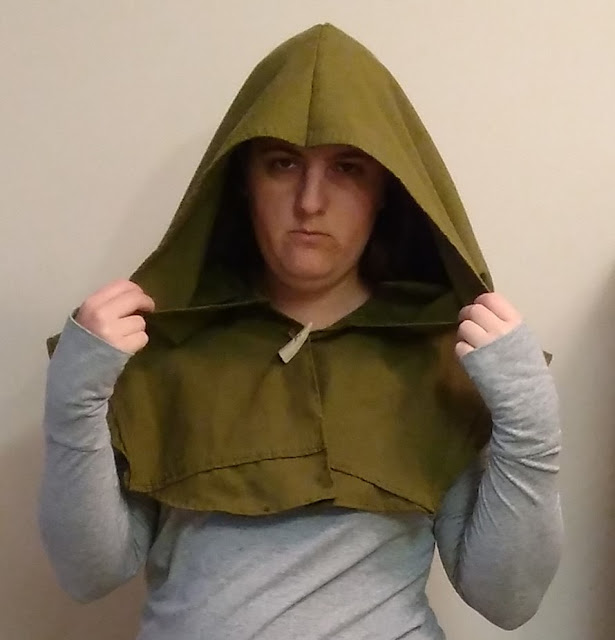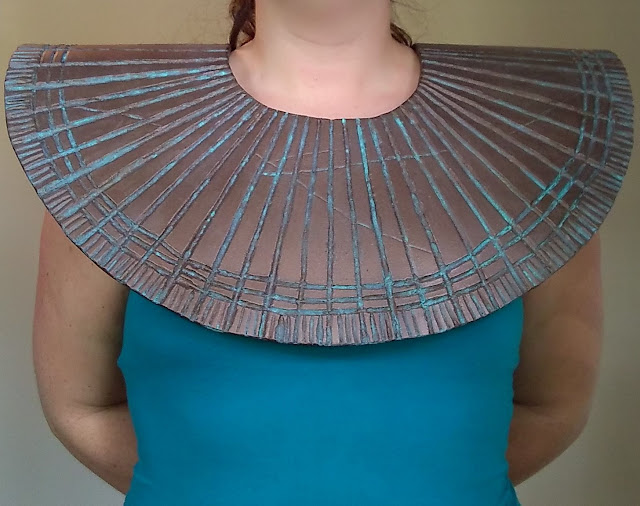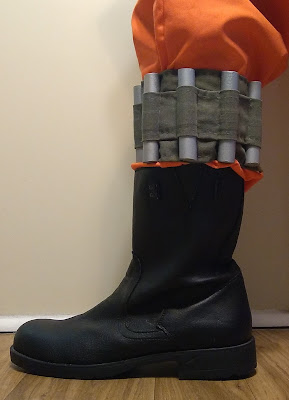How to make a light-up crystal artifact
So if your high fantasy character is wandering through tangled forests, treacherous mountainsides, and haunted ruins, sooner or later they're going to stumble into some loot. Whether they are valuable resources, ensorcelled artifacts, or technology of a fallen civilization, something like this light-up crystal device could make a great prop for cosplay or for role-playing board games like Dungeons and Dragons. It also makes a nifty little light.
For this project I was inspired by some posts on Pinterest, about light-up crystals that were based around tea-lights or other LED lights, made to be board pieces for roleplaying games. On the left is an unknown creator and unknown pin, but likely build up around a tea light. On the left is a project by Big Beekee Killa, an LED objective marker with a weight-sensitive trigger for the light. Because I have a fondness for and overabundance of puck lights, I decided to make this the base light source for my own version of these projects.
Materials
-Small puck light
-Metallic bronze spray paint
-Clear enamel coat spray paint
-Clear-sided ballpoint pens
-Plastic wrap
-Craft moss
Tools
1. Gather the materials
All of these materials can be found very easily. I bought a pack of cheap clear-sided ballpoint pens from the dollar store, a puck light I found for a quarter at the thrift store, and had the plastic wrap on hand from the kitchen. The rest were tools and paints I already had, and could be purchased at any hardware store.
2. Paint the base
After covering the light with masking tape, I spray-painted the puck light a dark metallic bronze. You could use a variety of colors, but I chose the dark bronze because it is dark like ancient metal or stone, and give the base a sense of texture that a flat or glossy solid color paint would not. After spraying a few layers and letting it dry between coats, I added a top coat of clear coat enamel to seal in the color.
3. Cut the crystals
I didn’t quite know what I was looking for, but when I saw these ballpoint pens in the dollar store I knew they could be useful. They’re a little more rounded than true crystal, but they’re hexagonal and clear enough to carry light. I disassembled the pens by prying off the ballpoint tips and ends with the pliers, then cut the pens to various lengths with the hacksaw. I cut their upright ends at an angle to mimic crystal points, and though they ended up being more jagged than I anticipated I think it works all right. I cut up maybe four pens, but depending on the size of the puck light and the desired height of the crystal formation you could end up using many more.
4. Add the occlusions
In most real crystals there are occlusions, or cracks and imperfections that catch the light. To recreate this and to try to have the light reflected throughout the crystal points, I tore off small strands of plastic wrap and pushed them through the pen pieces. It doesn’t need much, and I found it’s better to have it loose than to pack it full. I experimented a little with aluminum foil and dripped glue, but odds are there are better ways to do this that others have thought of first.
5. Create the formation
Making it look like a chunk of crystal was easy enough. All I had to do was use superglue to attach the tubes together, staggering their heights.
6. Finishing touches
Odds are the crystals don’t cover all the lit area of the puck light. For me, I painted the remaining area black. This color didn’t really matter so much, as long as it was dark enough to block the remaining light. It was soon to be covered anyway.
Anyway, there you have it, a nice prop that could be tweaked with a bit different paint or final touches for fantasy, steampunk, aliens, or a dozen other genres. Good luck and keep crafting!
For this project I was inspired by some posts on Pinterest, about light-up crystals that were based around tea-lights or other LED lights, made to be board pieces for roleplaying games. On the left is an unknown creator and unknown pin, but likely build up around a tea light. On the left is a project by Big Beekee Killa, an LED objective marker with a weight-sensitive trigger for the light. Because I have a fondness for and overabundance of puck lights, I decided to make this the base light source for my own version of these projects.
Materials
-Small puck light
-Metallic bronze spray paint
-Clear enamel coat spray paint
-Clear-sided ballpoint pens
-Plastic wrap
-Craft moss
Tools
-Superglue
-Hacksaw
-Pliers
1. Gather the materials
All of these materials can be found very easily. I bought a pack of cheap clear-sided ballpoint pens from the dollar store, a puck light I found for a quarter at the thrift store, and had the plastic wrap on hand from the kitchen. The rest were tools and paints I already had, and could be purchased at any hardware store.
2. Paint the base
After covering the light with masking tape, I spray-painted the puck light a dark metallic bronze. You could use a variety of colors, but I chose the dark bronze because it is dark like ancient metal or stone, and give the base a sense of texture that a flat or glossy solid color paint would not. After spraying a few layers and letting it dry between coats, I added a top coat of clear coat enamel to seal in the color.
3. Cut the crystals
I didn’t quite know what I was looking for, but when I saw these ballpoint pens in the dollar store I knew they could be useful. They’re a little more rounded than true crystal, but they’re hexagonal and clear enough to carry light. I disassembled the pens by prying off the ballpoint tips and ends with the pliers, then cut the pens to various lengths with the hacksaw. I cut their upright ends at an angle to mimic crystal points, and though they ended up being more jagged than I anticipated I think it works all right. I cut up maybe four pens, but depending on the size of the puck light and the desired height of the crystal formation you could end up using many more.
4. Add the occlusions
In most real crystals there are occlusions, or cracks and imperfections that catch the light. To recreate this and to try to have the light reflected throughout the crystal points, I tore off small strands of plastic wrap and pushed them through the pen pieces. It doesn’t need much, and I found it’s better to have it loose than to pack it full. I experimented a little with aluminum foil and dripped glue, but odds are there are better ways to do this that others have thought of first.
5. Create the formation
Making it look like a chunk of crystal was easy enough. All I had to do was use superglue to attach the tubes together, staggering their heights.
Make sure the bottoms of the points are either even or follow the curve of the puck light as much as possible. See where the formation will sit on the light, and maneuver it around so there is at least one spot open on the light that is sensitive enough to press the light on and off. You don’t want to put the crystal on top of that, otherwise you risk breaking off the crystal every time you turn the light on or off. Once done, I used a #%*@ ton of superglue to attach the formation to the top of the puck light and let it dry.
6. Finishing touches
Odds are the crystals don’t cover all the lit area of the puck light. For me, I painted the remaining area black. This color didn’t really matter so much, as long as it was dark enough to block the remaining light. It was soon to be covered anyway.
Last, I decided to glue some moss down to add to the finishing touches. I also considered paint the edges with runes, but ultimately decided the moss would be better at obscuring the more modern shape of the puck light. The moss gives it a feel of age, as if it was lost in a forgotten ruin. It also looks cool, which is generally the goal. I painted the rune "dagaz" next to the best spot to press the puck light on and off, which seemed appropriate since it's the rune for day.
Anyway, there you have it, a nice prop that could be tweaked with a bit different paint or final touches for fantasy, steampunk, aliens, or a dozen other genres. Good luck and keep crafting!



















Comments
Post a Comment